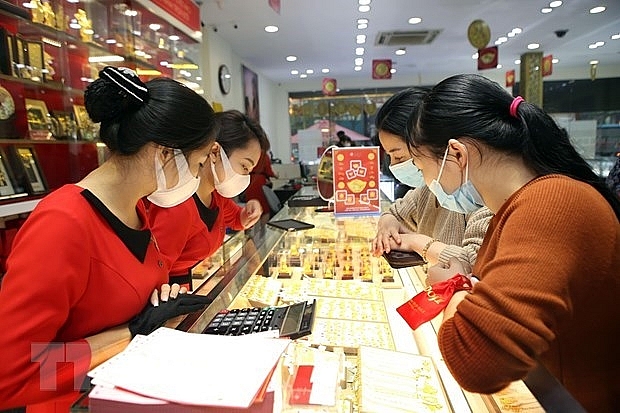Global uncertainties pushing gold prices to record highs
Global uncertainties pushing gold prices to record highs
The Vietnamese gold price will likely continue to spike, reflecting the growing anxiety around increasing coronavirus presence in the country and beyond.

A gold shop in Hanoi (Photo: VNA)
|
After a few months of near-complete safety from COVID-19, an outbreak in Danang at the end of last month has created new tension for Vietnam, but with three related deaths reported as of noon August 1.
As a result, the gold bar price in the local market in recent weeks has constantly broken records, at one point hitting over VND58 million ($2,522) per tael. Domestic gold prices complied with the increase in global gold prices and maintained a difference of VND1-3 million ($43-$130) per tael higher than worldwide prices. Gold continuously increased in price by more than 50 per cent over the past year, before surging significantly in the last two weeks.
The metal rose persistently two years ago, spurred by global trade tensions and geopolitical conflicts. And more recently, various public health challenges have also added fire to the fuel, pushing investors to seek for safer assets.
Ngo Tri Vinh, analyst at Bao Viet Securities, explained, “The driver of this increase is that the world has been facing various uncertainties simultaneously, including pandemic and general geopolitical instability, as well as dealing with the fiscal and monetary policies of governments worldwide injecting large and low-cost money into the economy.”
For example, he added, in the last four months the Fed’s balance sheet in the United States expanded by almost $3 trillion to over $7 trillion. The expansion in this period is almost the same as that seen in the period of 2008-2014 when the economy struggled with the global recession stemming from the financial crisis.
Besides that, ultra-low interest rates make bullion become more attractive, since the metal offers no income simply from holding it.
“A tepid economic outlook, a decline in interest rates, and rising tensions among nations along with US dollar depreciation have fuelled the surge of bullion’s price as people would look for assets they perceive to be havens,” Tran Thang Long, head of Research at BIDV Securities Company (BSC), told VIR.
In the long term, the inflation risks from huge monetary and fiscal policies to cope with the pandemic also boost the demand for this safe haven asset. Gold prices zoomed to a record high last week, as a weakening US dollar injected new momentum into an upsurge driven by uncertainty about the world economy.
Otherwise, US dollar deflation will mostly ease pressure on the currencies of emerging and frontier markets highly exposed to export activities, including the VND, which helps stabilise other domestic macro factors such as interest rates and inflation.
There will be potential exposures on the nation’s trade balance – if any other exporters’ currencies are going to be devaluated against the US dollar while the VND remains stable, Vietnam will experience more expensive exports and cheaper imports. However, this phenomenon is not a cause for concern so far, given a recorded $6.5-billion trade surplus in the first seven months of the year.
In Vietnam, gold bar trading has been constrained for many years under 2011’s Resolution No.11/NQ-CP on controlling inflation and stabilising the macro-economy and gold trading activities. Therefore, the surge of global gold prices, albeit raising the domestic price, did not significantly disturb gold trading businesses.
Stable domestic gold trading has helped maintain the stability of the exchange rate and people’s deposits. However, although gold has always gained its status through its defensive nature, it is only safe when investors can purchase at an attractive price.
According to Vinh from Bao Viet Securities, in the short run, the recent skyrocketing gold price has not set many burdens on locally-branded gold jewellery retailers in general, as most of their item prices do not directly benchmark the daily gold price.
For instance, PNJ has been hoarding low-cost gold raw materials since the end of the first quarter; therefore, the company can adjust the selling price to support sales volume when the purchasing power is more or less affected by the pandemic.
However, Vinh told VIR, if gold prices remain high for a long time its raw material cost will increase, while selling prices are unlikely to rise correspondingly when jewellery purchasing power cannot maintain the same as previous years, as the economy and people’s income have been heavily affected by the pandemic. Echoing this, Long from BSC said a gold price increase is not a good thing for jewellery groups as gold (as well as silver, platinum, and others) is a raw material. “When material prices increase, buyers are less likely to purchase jewellery. They could buy gold bars but this product has low profit margins.”

























